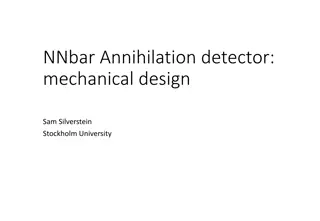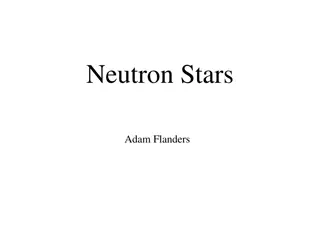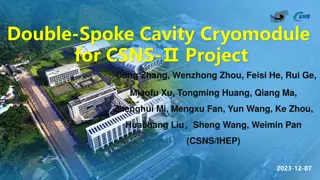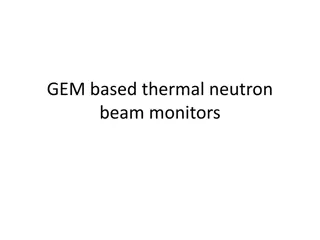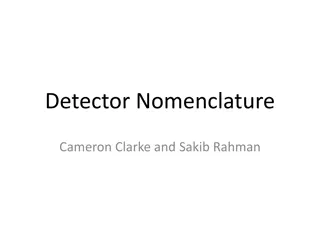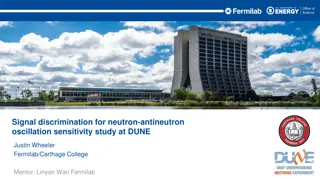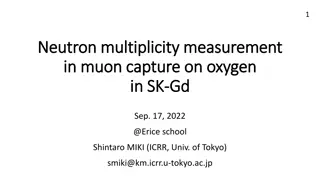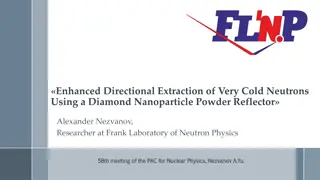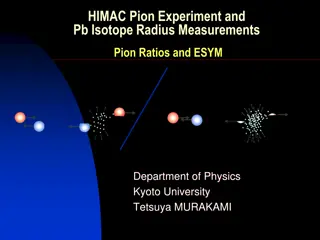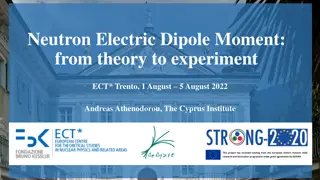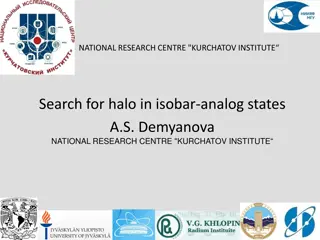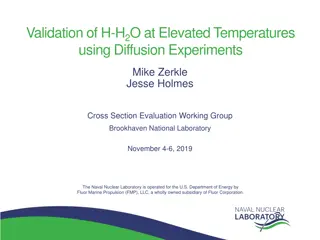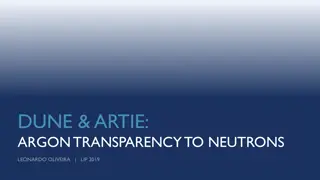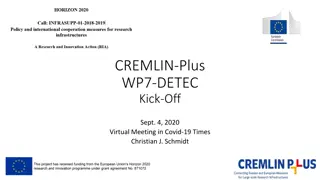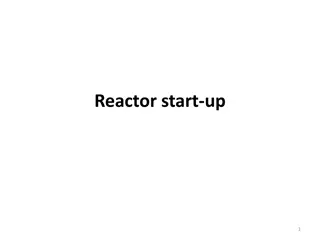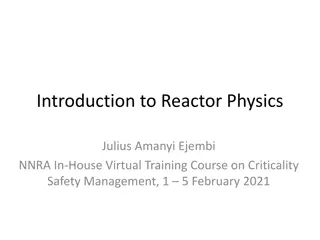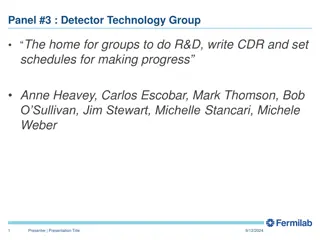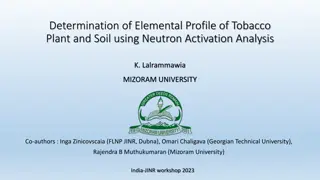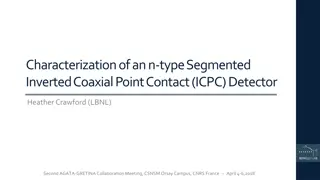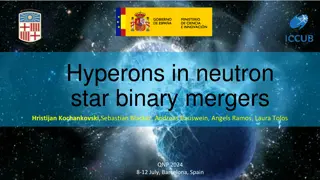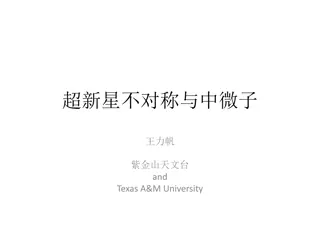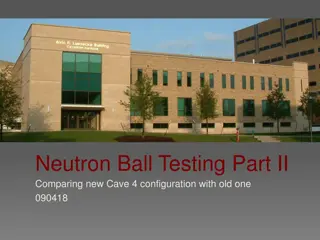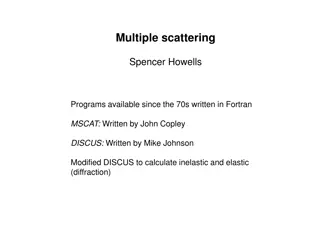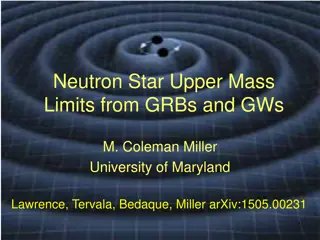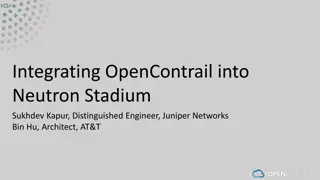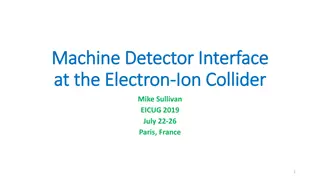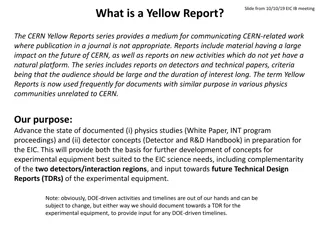ECFA Detector R&D Roadmap and International Collaborations Update
The ECFA Detector R&D Roadmap outlines collaborative efforts in particle physics research, focusing on high-field magnets, muon beams, and more. Task Forces are coordinating community consultations for future experimental programs, with a goal to fulfill strategic needs identified by the ESPP update
0 views • 28 slides
Innovative Approach to Radioisotope Production Using IFMIF-DONES Neutron Source
An assessment on the production of radioisotopes in the IFMIF-DONES test cell highlights the significance of 99Mo, the precursor of Technetium-99m used in radiopharmaceutical applications. The global shortage of 99Mo due to reactor maintenance issues has led to the exploration of alternative methods
3 views • 20 slides
NNbar Annihilation Detector Mechanical Design Proposal
This proposal outlines the mechanical design considerations for the NNbar Annihilation Detector, highlighting practical concerns and proposed changes to the baseline design. Topics cover the structure support, component weights, installation challenges, and optimizations for improved detector perfor
2 views • 27 slides
European Spallation Source Neutron Instrument Project Overview
The European Spallation Source (ESS) Neutron Instrument Project aims to develop 15 world-leading neutron instruments by 2023. The project involves instrument classes, performance targets, budget considerations, and a planned schedule for instrument commencement. The NSS project scope includes reduci
4 views • 18 slides
Exploration of Single Neutron Transfer on 68Ni at ISOLDE Workshop
Delve into the research on single-neutron transfer on 68Ni conducted by Andreas Ceulemans at the ISOLDE Workshop and Users Meeting in November 2023. The investigation focuses on the significance of studying nickel isotopes, the magicity and collectivity near 68Ni, and the use of shell model calculat
5 views • 26 slides
Exploring Neutron Stars: Discoveries and Characteristics
Neutron stars, initially proposed in 1933, have been the subject of various discoveries and studies. They are characterized by their unique properties such as compactness, high density, rapid spinning, and strong magnetic fields. Neutron stars are predominantly composed of neutrons, with other parti
1 views • 23 slides
Understanding Nuclear Structure and Forces in Physical Science
Explore the fascinating world of nuclear structure and reactions within atoms, delving into concepts such as nuclear force, binding energy, mass defect, and nuclear stability. Discover the intricacies of nucleons, neutron stars, and the Band of Stability, along with magic numbers that contribute to
6 views • 9 slides
Advanced Cryomodule Technology for China's Spallation Neutron Source Upgrade
This article discusses the development of a Double-Spoke Cavity Cryomodule for the China Spallation Neutron Source (CSNS) project. It covers the structure of the cryomodule, integration processes, future work, and details about the CSNS beam parameters and upgrade scheme. The content includes images
0 views • 19 slides
Innovative Solutions for Thermal Neutron Beam Monitoring
Cutting-edge detector solutions are proposed for thermal neutron beam monitoring, utilizing various configurations such as head-on bGEM with electronics, bGEM with side electronics, and side-on bGEM TPC-like setups. These solutions offer precise detection capabilities within specified envelope dimen
0 views • 7 slides
Advanced Detector Nomenclature and Proposed Segmentation System
This content provides detailed information on detector nomenclature, parts, and a proposed segmentation system for advanced spectrometers. It includes visuals and explanations of ring, septant, coil, and segment identification within the detector, offering insights into the intricate workings of spe
0 views • 4 slides
Estimation of Dead-Time Loss for Neutron Count-Rates
This study discusses the estimation of dead-time loss for high neutron count-rates and the associated multiplicity correction using multi-channel list-mode data. The numerical method for high count-rate dead-time correction in neutron multiplicity counting is described, focusing on the use of multi-
0 views • 6 slides
Neutron-Antineutron Oscillation Sensitivity Study at DUNE
The study at DUNE focuses on discriminating signals for neutron-antineutron oscillation sensitivity, aiming to measure CP violation and explore BSM physics. DUNE uses a Liquid Argon Time Projection Chamber to search for antineutron annihilation in nuclei, branching ratios, and interaction products s
0 views • 10 slides
Neutron Multiplicity Measurement in Muon Capture on Oxygen in Super-Kamiokande
Explore the neutron multiplicity measurement in muon capture on oxygen using Super-Kamiokande, a water-Cherenkov detector located underground in Japan. Gadolinium was added to enhance neutron tagging efficiency, aiding in Supernova observation, proton decay rejection, and more. Neutron signals are t
0 views • 16 slides
Advanced Fission Experiments at University of Michigan
The University of Michigan, under the guidance of Dr. Sara A. Pozzi, conducts cutting-edge fission experiments leveraging organic scintillation detectors. These detectors offer advantages such as nanosecond-scale response times, energy proportionality, and scalability. The experiments focus on impro
0 views • 4 slides
Enhanced Directional Extraction of Very Cold Neutrons Using Diamond Nanoparticle Reflector
Alexander Nezvanov, a researcher at Frank Laboratory of Neutron Physics, presented a study on enhanced directional extraction of very cold neutrons using a diamond nanoparticle powder reflector. Very cold neutrons (VCN) have unique properties making them ideal for various applications in neutron tec
0 views • 11 slides
Nuclear Physics Research Highlights: Neutron Stars, Nuclear EOS, and Pb Isotope Studies
Explore cutting-edge research in nuclear physics, including experiments on pion ratios and Pb isotope radius measurements, neutron star observations, neutron density distributions of Pb isotopes, and polarized proton beams at Osaka University. Learn about the analysis of realistic point proton densi
0 views • 26 slides
Workshop on Neutron Electric Dipole Moment: Theory to Experiment
Workshop on Neutron Electric Dipole Moment: Theory to Experiment will be held in Trento from August 1st to August 5th, 2022. The event aims to bridge the gap between theory and experiment in investigating the neutron EDM in Lattice QCD, Phenomenology, and Cosmology. Renowned speakers and financial s
1 views • 10 slides
Exploring Nucleonic Halos in Isobar-Analog States at Kurchatov Institute
The research at Kurchatov Institute focuses on investigating nucleonic halos in isobar-analog states (IASs) of nuclei, aiming to understand the structure and properties of exotic nuclei with neutron halos. Neutron halos, characterized by enlarged radii of valence neutrons, have been observed in both
0 views • 15 slides
Calculation and Validation of Thermal Neutron Diffusion Length in Water at Elevated Temperatures
This research focuses on the validation of thermal neutron diffusion experiments in water at elevated temperatures. Various methods, including the pulsed-neutron die-away and static relaxation length methods, were used to determine the diffusion length (L). Through linear and power fits based on dat
0 views • 7 slides
Insights into Neutron Stars: Observations and Implications
Exploring the fascinating realm of neutron stars through astronomical observations and the implications for equations of state (EOS). Delve into the mysteries of neutron star properties, measurement results from projects like PREX/CREX, and the significance of NS masses, tidal deformabilities, and r
0 views • 24 slides
Closeout Report: Incremental Design Review of EIC Detector Electronics
Closeout report detailing the progress of the Incremental Preliminary Design and Safety Review of the EIC Detector DAQ and Electronics, along with the Final Design Review of Electronics Components for the ePIC Detector. The report includes responses to charge questions, panel reviews, comments, reco
0 views • 23 slides
Neutrino Detectors for NuStorm: Physics Goals and Detector Requirements
Physics goals for neutrino detectors in the NuStorm project include measuring exclusive neutrino cross sections, supporting long baseline programs, searching for sterile neutrinos, and improving measurements. Detector requirements involve reconstructing neutrino interactions, providing charge and pa
0 views • 21 slides
Exploring Neutrons and Argon in the DUNE and ARTIE Experiments
Detailed overview of experiments like DUNE and ARTIE focusing on the use of liquid argon time projection chambers for studying neutron interactions. Discussions include Pulsed Neutron Source calibration, scattering length measurements, ARTIE setup for resonant transport interactions, and current sim
2 views • 10 slides
Advancing Neutron Sources for Complementary Experiments at DONES
Exploring further potential for utilizing fast neutron sources, the DONES project aims to expand its scope beyond fusion materials studies. The ELAMAT Consortium, spearheading the bid for hosting DONES in Poland, envisions incorporating additional scientific areas for complementary research. Complem
0 views • 7 slides
WP7-DETEC Kick-Off Meeting: Advancing Detector Technologies for Particle Physics
WP7-DETEC is a collaborative initiative focusing on the development of state-of-the-art detector technologies in the fields of nuclear physics and high-energy physics. The kick-off meeting aims to foster cooperation, exchange ideas, and educate young scientists in the field. Activities include sessi
0 views • 7 slides
Understanding Reactor Start-up and Neutron Multiplication in Subcritical Reactors
Reactor start-up is a crucial operation that transitions a reactor from a subcritical state to a critical state by carefully adjusting reactivity levels. In a subcritical reactor, the neutron density should decrease over time but may not reach zero due to certain factors. Neutron multiplication fact
0 views • 66 slides
Introduction to Reactor Physics and Nuclear Fission
Explore the fundamentals of reactor physics, neutron interaction, and nuclear fission in this virtual training course on criticality safety management. Delve into the history of nuclear fission, symbolisms for atoms, and the significance of critical reactors like Fermi's Chicago Pile. Gain insights
0 views • 73 slides
Detector Technology Group: Research & Development Strategies
The Detector Technology Group focuses on R&D for detector technology, setting schedules to make progress. Discussions include short-term approaches for describing detectors, collaboration participation, and decision-making. Activities at CERN and Fermilab are reviewed to address any missing R&D area
0 views • 8 slides
Determination of Elemental Profile of Tobacco Plant and Soil Using Neutron Activation Analysis
The study focuses on analyzing the elemental profile of tobacco plants and soil in Mizoram, India, utilizing neutron activation analysis. It explores how various factors influence the accumulation of heavy elements in tobacco leaves and the potential health implications of high tobacco consumption i
0 views • 20 slides
Innovative n-Type Segmented Inverted Coaxial HPGe Detector Study
Comprehensive characterization of an n-type Segmented Inverted Coaxial Point Contact (ICPC) detector by Heather Crawford at the AGATA-GRETINA collaboration meeting. The study focuses on energy resolution, drift time corrections, azimuthal angle and full position reconstruction, along with in-beam ch
0 views • 29 slides
Hyperons in Neutron Star Binary Mergers - Research Insights
Research on hyperons in neutron star binary mergers explores the influence of high temperatures, equilibrated matter characteristics, and post-merger frequencies. The study investigates the impact of hyperonic equations of state and the challenges in inferring matter composition. The findings sugges
0 views • 25 slides
Exploring Dark Matter in Neutron Stars
Investigate the interaction of dark matter within neutron stars, comprising approximately 25% of the universe's total matter. The nature of dark matter assumptions, its distribution within neutron stars based on fermionic or bosonic properties, and the implications for self-interacting fermionic and
0 views • 22 slides
The Physics of Supernovae and Neutron Stars
Explore the fascinating world of supernovae and neutron stars through historical postulations, Nobel Prize-worthy discoveries, multi-dimensional simulations, and paradigm shifts in understanding asymmetric supernovae. Dive into the complexities of core-collapse mechanisms, jet formations, and the po
0 views • 35 slides
Comparison of New and Old Cave Configurations in Neutron Ball Testing
This content discusses the comparison between the new and old cave configurations in the Neutron Ball testing part II. It showcases images and descriptions of the different cave configurations, highlighting the progress in research at the Cyclotron Institute. The Neutron Ball's functionality and tes
0 views • 14 slides
Understanding Multiple Scattering Programs in Fortran for Neutron Diffraction and Inelastic Analysis
Multiple scattering programs like MSCAT and DISCUS, written in Fortran since the 70s, are essential tools for neutron diffraction and inelastic analysis. These programs allow for the calculation of neutron cross-sections, scattering angles, and sample geometries. The results obtained include elastic
0 views • 8 slides
Exploring Water on the Moon: Research Insights from Lunar Missions
Uncover the intriguing research on water presence on the Moon through the Lunar Reconnaissance Orbiter and the Lunar Exploration Neutron Detector. Discover how remote sensing and neutron detection technologies have shaped our understanding of lunar water distribution, challenging previous theories.
0 views • 23 slides
Neutron Star Upper Mass Limits from GRBs and GWs Research Insights
Analysis of neutron star upper mass limits derived from gamma-ray bursts (GRBs) and gravitational waves (GWs), indicating constraints on mass thresholds for NS-NS or NS-BH mergers. The study explores implications for LIGO detection rates, jet behaviors, and collapse scenarios. Future work suggestion
0 views • 5 slides
Integrating OpenContrail into Neutron Stadium - Networking Advancements
Integrating OpenContrail into Neutron Stadium introduces Networking-OpenContrail, bridging OpenContrail with Neutron to enhance network functionality. The project aims to achieve full parity between the two platforms, with active contributors encouraged to join the development efforts. Deployment op
0 views • 7 slides
Challenges and Considerations in Electron-Ion Collider Detector Development
Exploring the development of detector systems for Electron-Ion Colliders (EIC) involves addressing various issues such as detector acceptance for low Q2 and high Q2, unique beam characteristics, and the need for specialized components like bend magnets and polarimeters. Key considerations include po
0 views • 16 slides
Communication Strategies and Reports for Advancing Physics Studies and Detector Concepts at EIC
CERN Yellow Reports provide a platform for sharing impactful work related to CERN, including reports on detectors, technical papers, and new activities. The goal is to advance physics studies and detector concepts in preparation for the EIC, focusing on quantifying physics measurements, implications
0 views • 10 slides


